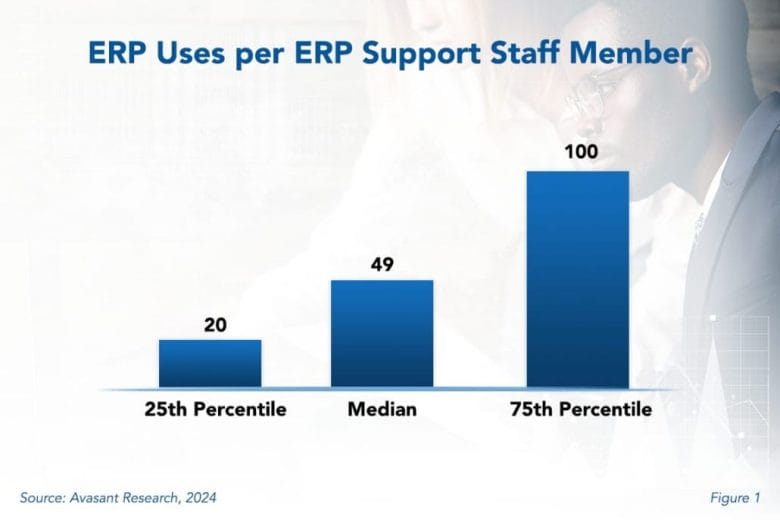For many IT organizations, enterprise resource planning (ERP) systems are at the center of the application portfolio, and understanding the support requirements of these systems is critical. The age of the system, type of deployment, and changes to business logic can drastically altersupport needs. Getting the support staffing wrong for your ERP system can be expensive, not just in support costs but in unmet business needs.
ERP systems can be major investments requiring substantial effort for implementation. Yet many organizations do not realize that over the life of an ERP system, the total cost of ownership is composed largely of ongoing support. To better understand the support requirements for ERP systems, we devised a simple ratio: the number of ERP users divided by the number of IT personnel providing ERP support. We call this the ERP support staffing ratio.
Figure 1 from our full report, ERP Support Staffing Ratios, shows the typical range of ERP support staffing ratios for installations of all sizes and types. At the median, there are 49 users per ERP support specialist, rising to 100 users per ERP specialist at the 75th percentile and falling to 20 users at the 25th percentile.

These statistics show a wide range of values for the ERP support staffing ratio. At the 75th percentile, there are five times as many users supported by each ERP support staff member than at the 25th percentile. Given this data, it is evident that other factors besides the number of users influence the level of ERP support staffing. These include the installation size, sector, installation maturity, and upgrade frequency.
“It can be hard to find the right number of support staff for ERP systems,” said Reneece Sterling, research analyst for Avasant Research, based in Los Angeles. “IT leaders must strike the right balance between support required for day-to-day operations and major upgrades.”
The full report reveals other interesting nuggets. Modern cloud ERP systems are steadily outpacing on-premises solutions in deployment. However, newer cloud ERP systems tend to require more support staff than legacy systems, which, due to their stability, tend to have lighter support requirements. However, as these cloud systems mature, we expect that the number ofrequired support personnel will decrease over time.
Our definition of ERP support personnel includes programmers, business analysts, project managers, database administrators, help desk personnel, systems programmers, ERP end-user reporting specialists, and training and documentation personnel—all of whom support ERP systems.
In the full report, we analyze ERP support requirements in several ways. First, we look at the ERP support staffing ratio, which is the number of users of the ERP system divided by the number of ERP support personnel. We then assess this ratio by the size of the ERP installation. We also examine the data to determine the ratios by vendors/systems where we have the largest number of respondents. We examine the ratio by sector, age of installation, years since the last upgrade, extent of modification, and type of deployment (on-premises, cloud, or hosted) as well. Finally, we provide recommendations for optimizing ERP staffing levels.
This Research Byte is a brief overview of our report on ERP Support Staffing Ratios. The full report is available at no charge for subscribers, or it may be purchased by non-clients directly from our website (click for pricing).

